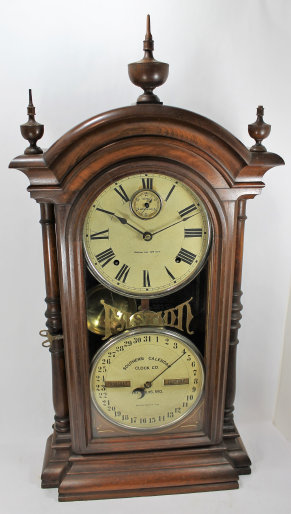

567. $1250
Gilbert Clock Co. “Bordeaux”, ca. 1904. It’s in Ly’s book Gilbert Clocks on page 109, but
I can’t find any sales records anywhere. It is 14 inches tall in a green “French plate crystal glass case” with “ormolu gold
mountings”, a signed porcelain dial with brass hands, and an outside escapement and a solid glass ball mounted on top. I believe
the spelter metal trim was painted long ago when the gilding wore off. It has a high-quality 8-day, signed round movement that
strikes the hours on a cathedral gong and the half-hour on a cup bell mounted above the movement. It is running and striking. The right rear arm piece of the trim is broken off at the top but is held stably in place by the mounting (see the photo). $1250-$2000.
Right
view Left view Back Movement

568. $950
T.C. Burleigh, Jr. presentation banjo, ca. 1980. A 40-inch weight-driven reproduction banjo
in the style of Willard presentation banjos from the early 1800’s. Gilded gesso on the beaded front, base and acorn finial. There is some loss to the gilding on the balls around the bottom. Both gilded glasses are original and in excellent shape. The painted dial is signed, the 8-day time-only movement is signed Kilbourn & Proctor, Inc. and is running. The lead weight
is a replacement. We sold one in 2017 for $1500. $1000-$1500.
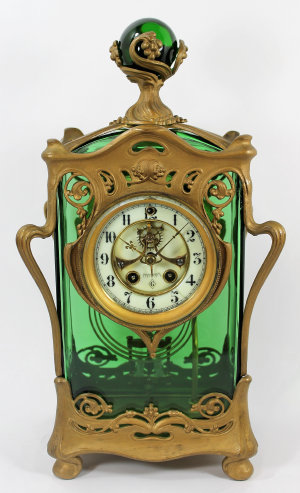
569. $1200
Seth Thomas “Parlor Calendar No. 8”, 1885. A 27.5-inch walnut case with maple trimmings and
two repainted dials, two old glasses. This one is too nice to sell. The signed 8-day time-and-strike spring-driven movement
is running and the perpetual calendar is advancing. Only flaws I can find: the calendar hand is a replacement, and there is
a small strip of missing veneer along the base – that could be made invisible with a bit of stain. Labels inside and date of
manufacture stamped on back. These typically sell for $2000+; the most recent one we sold was for $2660 in 2016. $1600-$2500.
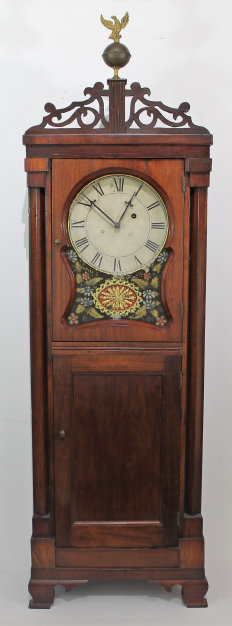
570. $2000
New England shelf clock, ca. 1830? This puzzling example of a New England shelf clock does
not follow a style typical of the period: it does not have a “box on box” form and does not have a removable bonnet. Indeed,
it more closely resembles a New England mirror clock, in particular because there are two now-filled openings in the top of the case
to accommodate weight pulleys that are not needed for the existing movement (and indicating that the current movement is a replacement). There are two doors, the upper holding an old glass in a kidney shape with a period eglomise design below the dial that is likely
original. The lower door appears to be a recent replacement; both doors are solid mahogany. The 38-inch mahogany-veneered
case itself appears to be very old, including the fretwork on top and the brass ball and eagle finial that look more appropriate to
an early tall-case clock. The front feet look original to the case, the turned back feet may be replacements. The pendulum
hangs behind the time-only pinned, brass plate movement as is typical for Massachusetts shelf clocks, with the iron weight hanging
in front of the pendulum; it may not be original, as these clocks usually have horizontal weights, and it only runs for 6 days. The dish-shaped painted iron dial is fastened to the 8-day movement; the hands are heavy iron, and it is running without problem. The interior wall paper is a recent addition. We cannot find a similar example for comparison; while its origin and history
are a puzzle, it is certainly old and certainly a lovely marriage. $2100-$2800.
Side view Open Top-1 Top-2 Back Movement

571. $1150
Ithaca Clock Co. “Large Iron Case”, ca. 1865. Iron cases were some of the first clocks
Ithaca made when they started business. They made two sizes and used different movements in each. This is the larger size,
21 inches, and is the more common model. It contains a Hubbell unsigned 30-day double-wind spring-driven pendulum movement,
although the dial is for a lever movement, which they also used. Additional covered winding holes in the dial pan suggest that
this dial has been co-opted for this clock. There is a perpetual calendar in the lower dial. Both dials are paper, as
originally made, and both have been varnished and yellowed; they can easily be replaced to brighten up the clock. The hands
are likely original, the upper glass is newer, the calendar glass is old. The most notable feature of this clock is the original
paint colors on the metal surround, as well as the original painted pendulum cover between the dials. This piece is often lost,
and the case is often repainted in black. Although the original colors are darkened, you can still see that the upper and lower
trim is gold, and the flowers and berries on the sides are red and green. The clock is running and the weekday calendar is advancing,
but the date hand needs adjustment. Two good labels on the back. We sold one a couple of years ago for $2175. $1500-$2000.
Side
view Movements Dial (back) Back

572. $750
Elmer Stennes “GM1” dwarf standing clock, ca. 1965. Stennes made clocks until his death in
1975. These dwarf standing clocks, or “grandmothers” are particularly desirable. The mahogany case with sandalwood inlay
is 60 inches tall to the top of the center brass urn finial and is in like-new condition. The painted metal dial is signed “Elmer
O. Stennes, Weymouth Mass”. The 8-day spring-driven movement includes a Westminster chime on 8 straight chime rods. It
is running and striking as expected. Stennes catalogs are included (see picture). We sold one a year ago for $1500. $1000-$1500.
Side view Open Movement Catalogs
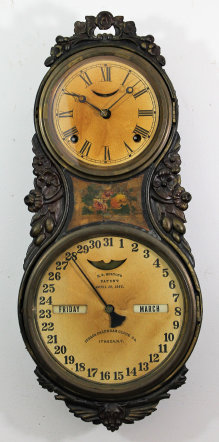
573. $975
Gilbert Clock Co. “Touraine”, ca. 1913. It’s in Ly’s book Gilbert Clocks on page 114, very
similar in style to #567. It is 14 inches tall in a rounded “French plate crystal glass case” with “ormolu gold mountings”,
a signed porcelain dial with brass hands, and an outside escapement and a solid glass ball mounted on top. Much of the gilding
has been worn off, but I don’t believe this one has been repainted. It has a high-quality 8-day, signed round movement that
strikes the hours on a cathedral gong and the half-hour on a cup bell mounted above the movement. It is running and striking. A rarely seen clock; I found a sale on eBay in 2014 for $2100. $1000-$1800.
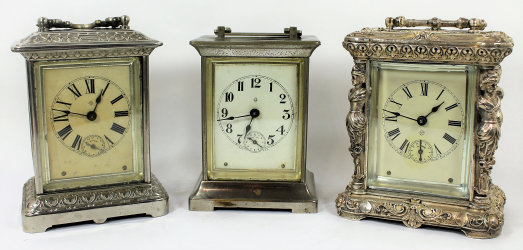
600. $150
Three large carriage clocks from the early 1900’s. On the left is an Ansonia “Carriage Extra” in
nickel, ca. 1904. This is 6.5 inches high with the handle down. The dial is glossy paper, slightly yellowed, with an inset
alarm dial. The hands are correct. The nickel case is in nice shape, needing only a bit of polish; no nicks, dings, or
dents that I see. The nickel back door opens to a backwind time, alarm, and half-hour strike on a bell under the base. The strike is off by 15 minutes so you will need to open the case and reposition the minute hand. The clock runs for a while
and then stops. It’s only a one-day clock anyway. These generally sell for around $150 on eBay when found in nickel. In the middle is an Ansonia “Tourist” nickel-plated carriage clock, ca. 1914. This also is a large carriage, 6 inches high with
the handle down. It’s only a one-day but has a strike and an alarm. It is running and keeping time but not striking. The alarm is working. The finish is not good, with considerable corrosion that will take some work to clear. The movement
and dial are signed. On the right is an Ansonia “Comet”, 1904. This also is a large carriage clock, 6.5 inches tall with
the handle down. The finish here is silver and the clock is quite heavy. Beveled glass in front over a 3-inch dial with
an alarm dial. This is the nicest of the three. The movement is signed in back but we can’t convince it to run. It’s a one-day that strikes on a bell underneath on the hour and half-hour. A couple of recent sales on eBay for about $125;
in silver this is quite nice. $150-$300.

601. $750
Southern Calendar Clock Co. “Fashion No. 4”, 1875-1889. Solid walnut with an old finish, 32
inches high with center finial. Finials are old and one has lost its spire. The dials show an old crackled paint
that I don’t think is original but is very old; they also are rather warped. Hands are correct; the day and month rollers
are yellowed but readable, and no doubt original. Old glass that I don’t think has ever been out of the door, the Fashion
gold lettering shows some wear. The pendulum bob is a replacement. The 8-day time-and-strike movement is clean and
signed “MANUF’D BY THE SETH THOMAS CLOCK CO. THOMASTON CT SOLELY FOR THE SOUTHERN CALENDAR CLOCK CO. ST. LOUIS MO.” Good labels inside. The
clock is running, keeping time, striking on the brass bell, and the calendar date hand is advancing but the weekday roller is not.
$1000-$1200.
Open Interior Movement Dials Back
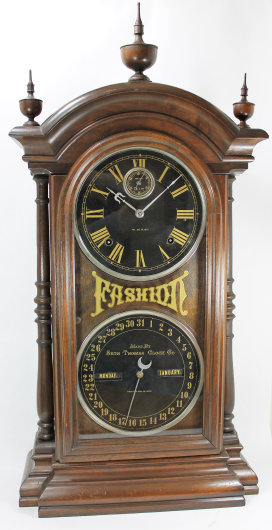
602. $500 updated
Southern Calendar Clock Co. “Fashion No. 5/6”, ca. 1877. This clock only
wishes it could be a No. 6. Don Hellstern kindly informed us that this is a marriage (I would use another word to describe it)
of parts from several Fashion clocks. While we knew the hands were painted or sanded (the calendar hand) rather than the
original nickel, we missed several other significant flaws. We noted that the door glass had been replaced, but we did
not realize the gold “Fashion” lettering was incorrect for the No. 6; the glass or door probably came from No. 3 or 4. The movement
is from a No. 5, very similar to a No. 6 movement, but the No. 6 movement is screwed to the A-frame, not pinned. Also, the interior
door label should be black, not white, as is found in a No. 5. So essentially, this is a No. 5 with black dials and glass from
an earlier model. Note that it does have the appropriate long-drop damascened pendulum. The wire gong is dated, and the
dials have the correct and expected patent dates and labeling “Made by Seth Thomas Clock Co”. The solid walnut case is in excellent
shape, with good replacement finials. There is a nice Southern Calendar Clock Co label on the back. The clock is running,
keeping time, striking on cue, and the calendar is advancing. We thank Don for the information; you can find a wealth of information
on Fashion calendars here. $500-$1000.
